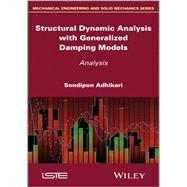
Note: Supplemental materials are not guaranteed with Rental or Used book purchases.
Purchase Benefits
Looking to rent a book? Rent Structural Dynamic Analysis with Generalized Damping Models Analysis [ISBN: 9781848215214] for the semester, quarter, and short term or search our site for other textbooks by Adhikari , Sondipon. Renting a textbook can save you up to 90% from the cost of buying.
1 Introduction to Damping Models 1
1.1 Historical review of vibration damping 1
1.2 Damping in structural elements 1
1.2.1 Material damping effects 1
1.2.2 Non-material damping effects 1
1.3 Viscous damping models 1
1.3.1 Proportional viscous damping 1
1.3.2 Non-proportional viscous damping 1
1.4 Viscoelastic damping 1
1.5 Fractional damping 1
1.6 General nonviscous damping models 1
1.7 Damping in composite materials and structures
1.8 Nonlinear damping models 1
1.9 Damping enhancement in vibrating systems 1
1.9.1 Tuned mass dampers 1
1.9.2 Friction dampers 1
1.9.3 Impact dampers 1
1.10 Experimental identification of damping 1
1.11 Scope of the book 1
2 Review of Undamped and Viscously Damped Systems 3
2.1 Single-degree-of-freedom systems 3
2.2 Multiple-degree-of-freedom undamped systems 3
2.2.1 Modal analysis 3
2.2.2 Dynamic response 5
2.3 Proportionally damped systems 7
2.3.1 Condition for proportional damping 8
2.3.2 Generalized proportional damping 9
2.3.3 Dynamic response 10
2.4 Non-proportionally damped systems 20
2.4.1 Free vibration and complex modes 21
2.4.2 Dynamic response 24
2.5 Continuous systems 28
2.5.1 Axial vibration of rods 28
2.5.2 Flexural vibration of beams 28
2.5.3 Bending vibration of thin plates 28
3 Nonviscously Damped Single-Degree-of-Freedom Systems 29
3.1 Introduction 29
3.2 The equation of motion 30
3.3 Conditions for oscillatory motion 32
3.4 Critical damping factors 36
3.5 Characteristics of the eigenvalues 37
3.5.1 Characteristics of the natural frequency 37
3.5.2 Characteristics of the decay rate corresponding to the oscillating mode 40
3.5.3 Characteristics of the decay rate corresponding to the non-oscillating mode 43
3.6 The frequency response function 44
3.7 Characteristics of the response amplitude 46
3.7.1 The frequency for the maximum response amplitude 47
3.7.2 The amplitude of the maximum dynamic response 55
3.8 Simplified analysis of the frequency response function 57
3.9 Summary 58
4 Nonviscously Damped Multiple-Degree-of-Freedom Systems 63
4.1 Introduction 63
4.1.1 Choice of the kernel function 64
4.1.2 The exponential model for MDOF nonviscously damped systems 66
4.2 The state-space formulation 68
4.2.1 Case A: All coefficient matrices are of full rank 68
4.2.2 Case B: coefficient matrices are rank deficient 71
4.3 The eigenvalue problem 73
4.3.1 Case A: All coefficient matrices are of full rank 74
4.3.2 Case B: coefficient matrices are rank deficient 76
4.4 Forced vibration response 77
4.4.1 Frequency domain analysis 77
4.4.2 Time domain analysis 78
4.5 Numerical examples 79
4.5.1 Example 1 79
4.5.2 Example 2 79
4.6 Concluding remarks 82
5 Nonviscously Damped Continuous Systems 85
5.1 Equation of motion 85
5.2 Models of damping 85
5.3 Axial vibration of rods with nonviscous damping 85
5.3.1 Equation of motion 85
5.3.2 Free vibration 85
5.3.3 Forced vibration 85
5.4 Flexural vibration of beams with nonviscous damping 85
5.4.1 Equation of motion 85
5.4.2 Free vibration 85
5.4.3 Forced vibration 85
5.5 Bending vibration of thin plates with nonviscous damping 85
5.5.1 Equation of motion 85
5.5.2 Free vibration 85
5.5.3 Forced vibration 85
6 Continuous Systems with Nonlocal Damping 87
6.1 Flexural vibration of beams with nonlocal damping 87
6.1.1 Exact solution using transfer matrix approach 87
6.1.2 Galerkin Approach 87
6.1.3 Finite Element Approach 87
6.2 Bending vibration of thin plates with nonlocal damping 87
6.2.1 Exact solution using transfer matrix approach 87
6.2.2 Galerkin Approach 87
6.2.3 Finite Element Approach 87
7 Experimental Identification of Damping 89
7.1 Identification of proportional viscous damping 89
7.1.1 The theory of damping identification 89
7.1.2 Numerical examples 89
7.1.3 Experimental results 89
7.2 Identification of non-proportional viscous damping 89
7.2.1 The theory of damping identification 89
7.2.2 Numerical examples 89
7.2.3 Experimental results 89
7.3 Identification of nonviscous damping 89
7.3.1 The theory of damping identification 89
7.3.2 Numerical examples 89
7.3.3 Experimental results 89
8 Parametric Sensitivity of Damped Systems 91
8.1 Review of parametric sensitivity of undamped systems 91
8.2 Parametric sensitivity of viscously systems 91
8.2.1 Sensitivity of the eigenvalues 91
8.2.2 Sensitivity of the eigenvectors 91
8.3 Parametric sensitivity of nonviscously systems 91
8.3.1 Sensitivity of the eigenvalues 91
8.3.2 Sensitivity of the eigenvectors 91
9 Computational Methods for Damped Systems 93
9.1 Single degree-of-freedom systems with one kernel function 93
9.2 Single degree-of-freedom systems with multiple kernel functions 93
9.3 Multiple degree-of-freedom systems with one kernel function 93
9.3.1 Calculation of the eigenvalues 93
9.3.2 Calculation of the eigenvector 93
9.4 Multiple degree-of-freedom systems with multiple kernel functions 93
9.4.1 Calculation of the eigenvalues 93
9.4.2 Calculation of the eigenvector 93
10 Advanced Topics in Nonviscously Damped Systems 95
10.1 Duffing’s oscillator with nonviscous damping 95
10.2 Nonviscously damped beams with impact 95
10.3 Linear systems with general nonviscous damping 95
10.3.1 Properties of the eigensolutions 95
10.3.2 Frequency response function 95
10.3.3 Transient response analysis 95
10.4 Asymmetric nonviscously damped systems 95
10.5 Active constrained layer damping 95
A Mathematical Preliminaries 97
A.1 Vector Spaces 97
A.2 Matrix Algebra 97
A.3 Laplace Transforms 97
References 99
The New copy of this book will include any supplemental materials advertised. Please check the title of the book to determine if it should include any access cards, study guides, lab manuals, CDs, etc.
The Used, Rental and eBook copies of this book are not guaranteed to include any supplemental materials. Typically, only the book itself is included. This is true even if the title states it includes any access cards, study guides, lab manuals, CDs, etc.